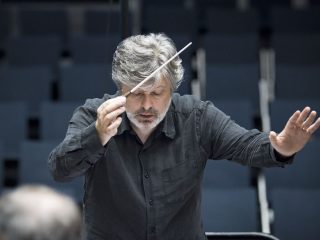
Kim Ashton
Kim Ashton’s music has been heard in concerts and festivals in the USA, France, Germany, Portugal, Sweden, Denmark, Belgium, Croatia, and throughout the UK. Kim’s love of the oboe dates back to the very start of his interest in music, when at the age of nine he took up the instrument. He went on to study the oboe at the Purcell School of Music and Royal Academy of Music, performing in such venues as the National Theatres in Burma, as well as more locally in the Purcell Room, Wigmore Hall, Festival Hall, and the Royal Albert Hall. Of his performance in Resphigi’s The Birds at the Proms The Telegraph wrote ‘one could not imagine more beautiful playing than that of 17-year old Kim Ashton’. When his interest in composing took over at University, the oboe took a back seat (he now plays baroque oboe on occasion), but it remains at the heart of his love of music.
Kim’s recent orchestral work Spindrift, written for the London Symphony Orchestra, is shortly to be released by the LSO on their own label, complementing existing recordings of his chamber pieces on the Lorelt and Nonclassical labels. Recent large-scale works have been performed by Ensemble InterContemporain, the Orchestra of the Age of Enlightenment, the Orchestra of Opera North, and Orquestra Gulbenkian, while he regularly collaborates with chamber groups and solo artists such as Lesley-Jane Rogers, Clare Hammond, Sound Intermedia, VOCAALLAB, The Hermes Experiment, and players from the LSO, Budapest Symphony Orchestra, and Ensemble 2E2M. His interest in opera/music theatre is reflected in a long-standing relationship with Paris-based theatre collective La Chambre Aux Echoes, while in the UK his music-theatre piece Tonseisha was performed at the 2014 Tête à Tête Opera Festival with funding from the Arts Council. During his PhD, Kim studied with Silvina Milstein and George Benjamin at King’s College London; he is now a visiting lecturer at Cambridge University, where for the last 10 years he has taught composition, history, and analysis.
Below are a selection of notes written by Kim on his recent compositions featuring the oboe.
Winged music
Pan from Britten’s Metamorphoses was always one of my favourite pieces to perform as an oboist, while I also loved playing the dramatic and humorous Legerdemain from Dorati’s Cinq Pieces, where the player suddenly speaks at the end. These pieces were part of my inspiration in writing a piece for solo oboe, which I wanted to be poetic but also theatrical. The result, Winged music, is a virtuosic piece of about 6 minutes duration which is unexpectedly dramatic, while in musical terms exploring the three characters I most strongly associate with the oboe: clear and commanding; light and playful; and lyrical, sad, or even despairing. Starting off in a very bold manner, the music moves between these different moods or characters in a mercurial manner. The piece is also concerned with memory: with the memorability of ‘modern music’, which it pokes fun at in a gentle manner, and with performing from memory. A rewarding but high-risk activity, playing from memory is especially exciting when performing a solo piece! Winged music must be performed without music, the performer dealing with a number of ‘memory lapses’ in striking, sometimes humorous, and increasingly creative ways. The piece is dedicated to Melanie Ragge, my enormously inspiring former oboe teacher.
Click here to view a sample of the score for Winged Music (PDF File)
Berceuse
Less a lullaby than a piece in search of a lullaby, Berceuse (for oboe and piano) is a piece shot through with melancholy which, after several increasingly dramatic outbursts, ends with a haunting cantabile fragment, as though offering a fleeting moment of reassurance. The opening echoes the start of Varese’s ensemble piece Octandre, which begins with a haunting oboe solo; the piece builds to a cadenza-like climax on a ringing top F with the piano playing peals of bell-like chords underneath. Not much more than 3 minutes long, the piece would make a short but nevertheless very substantial addition to a recital or audition programme.
Click here to view a sample of the score for Berceuse (PDF File)
Windswift, side-looker
A chamber piece for oboe, harp, and string quartet, Windswift, side-looker takes its name from a poem called ‘Here Hare Here’ by contemporary Dorset poet Elisabeth Bletsoe. Traditionally it was considered bad luck to see a hare, but this bad luck could be avoided if you immediately recited the many different names for a hare – which included such things as ‘fidget-foot’ and ‘stubble-stag’ as well as the names in the title of my piece. I wrote Windswift after seeing the incredible Heinz Holliger play a marathon programme at the Salzburg Festival which included – amongst many other pieces – the oboe quartet by Elliot Carter, a fantastic work which I had not heard before. To this group I added the harp, both delicate and fierce, which brings percussive edge and rich resonance to the group’s soundworld. Bletsoe’s poem, celebrating (and mourning) the life and death of a hare in a manner at once elegaic and brutal was the starting point for my piece, which sandwiches a lighter, more playful central section evoking the quicksilver nature of the hare (… and, of course, the oboe!) – between sections in which I aimed to write grieving music of searing lyricism.
Click here to view a sample of the score for Windswift Side-Looker (PDF File)
Other oboe repertoire
Other pieces for the oboe include Kanzan Shigyo’s Satori, a haunting song for soprano, oboe and piano which is my favourite of my earlier pieces, and Tombeau d’oboe, a more recent piece for solo baroque oboe, which makes dramatic use of the possibility of glissandi on the open-holed period instrument. The title of this latter piece refers, of course, to Ravel’s Tombeau de Couperin, the opening solo of which any self-respecting oboist has practiced, if not to death, then to despair! It also refers to another Tombeau by the seventeenth-century composer Froberger, who wrote a piece to commemorate Monsieur Blancrocher (a lute player who died after falling down a flight of stairs). Such themes – themes of despair and descent – pervade the short piece, leading to a striking and memorable concluding gesture.
Click here to view a sample of the score for Kanzan Shigyo’s Satori (PDF File)
Click the image below to view a sample of Tombeau d’oboe
 Kim is very happy to provide complete scores and answer any questions – do get in touch via his website (https://kimbashton.wordpress.com/).
Kim is very happy to provide complete scores and answer any questions – do get in touch via his website (https://kimbashton.wordpress.com/).



